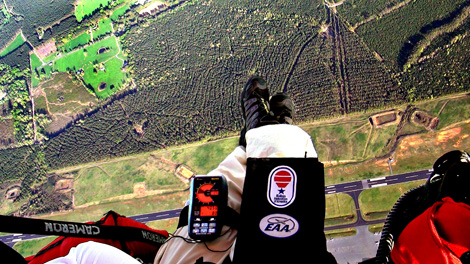
Cluster ballooning was born in chaos on July 2, 1982, when the late Lawn Chair Larry Walters soared to 16,000 feet in busy Los Angeles airspace.
The FAA fined him $1,500 for having an uncertificated Sears lawn chair (that wasn’t the exact wording), and for operating in Long Beach, Calif., airspace without contacting the tower. His pilot certificate would have been suspended if only he had one. There’s a picture of the chair on markbarry.com.
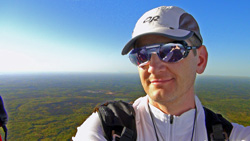 Jonathan Trappe, cluster ballooner.
Jonathan Trappe, cluster ballooner.
Today, just 28 years later, cluster ballooning has grown to two certificated pilots. Okay, that’s not much, but the professionalism is way up there. Jonathan R. Trappe of Raleigh, N.C., is a private “lighter-than-air free balloon pilot” with the standard limitation requiring a hot-air heater removed. That means he’s legal to fly a gas balloon, or in his case, to herd a bunch of gas balloons through the sky.
In June, he hopes to drive his herd across the English Channel, and has already discussed it with English and French aviation and customs authorities.
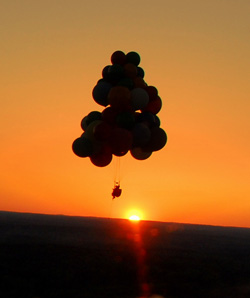 There are two other differences between the flight made 18 years ago and those already flown by Trappe. First, the chair has been replaced by a carbon fiber cradle. The Steelcase Uno office chair Trappe first tried was retired after it threatened to dump him during the descent. The chair tipped further forward each time another balloon was released (about 50 balloons are used). Had he slipped out of it, he would have inelegantly dangled from a two-foot safety link. The balloons are the same as those used for advertising. You may have seen one above a car dealer or large discount store.
There are two other differences between the flight made 18 years ago and those already flown by Trappe. First, the chair has been replaced by a carbon fiber cradle. The Steelcase Uno office chair Trappe first tried was retired after it threatened to dump him during the descent. The chair tipped further forward each time another balloon was released (about 50 balloons are used). Had he slipped out of it, he would have inelegantly dangled from a two-foot safety link. The balloons are the same as those used for advertising. You may have seen one above a car dealer or large discount store.
Second, the vehicle has an official N number and airworthiness certificate—Experimental Exhibition Manned Free Balloon N878UP. It’s not actually the chair, but the balloons, that are certified. Yet some of the balloons are released in flight, introducing the question, where does the N number attach? Trappe has it on a banner above his head between two risers connecting the balloons to the cradle.
 Jonathan R. Trappe's cluster balloon design breakout view.
Jonathan R. Trappe's cluster balloon design breakout view.
When Trappe’s document package first arrived at the Greensboro, N.C., FAA flight standards district office (FSDO), it was greeted with quizzical stares. Was this for real? Soon the FSDO staff became believers. Trappe had prepared a professional set of documents and actual balloon materials that went above and beyond certification requirements. It remains the only cluster balloon with an airworthiness certificate in the United States. 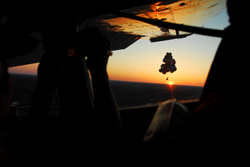
So, what does the hot-air ballooning community think of it? “Done properly by an experienced aviator, there’s nothing wrong with it,” said Andy Baird, vice president (United States) of Cameron Balloons, builder of the Breitling Orbiter III, the first balloon to fly around the world—and the Spirit of Freedom, the first solo round-the-world balloon flight. Baird is also an at-large board member of the Balloon Federation of America. “It’s what backpacking is to RV-ing. It is a minimalist approach to hot-air ballooning,” he said.
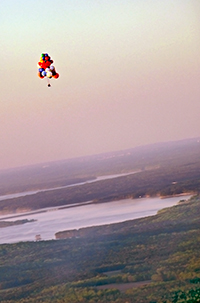 There’s an element of backpacking involved in flying a cluster balloon. The pilot can climb and arrest the climb, descend and arrest the descent, and fly level without any extraordinary effort or skill by the pilot. Trappe takes as much as 350 pounds of water with him—it’s his fuel—carried in MSR Dromedary bags used by hikers and campers. When he wants to climb, he releases water. When he wants to descend, he can release a balloon, release just the gas in a balloon, or pull down the nearest balloon and knife it to deflation. To land, he’ll release balloons at the treetops and may spend a few minutes doing what he calls “kicking trees.” Literally. If the descent rate is too high, he will release more water and usually lands at 50 feet per minute.
There’s an element of backpacking involved in flying a cluster balloon. The pilot can climb and arrest the climb, descend and arrest the descent, and fly level without any extraordinary effort or skill by the pilot. Trappe takes as much as 350 pounds of water with him—it’s his fuel—carried in MSR Dromedary bags used by hikers and campers. When he wants to climb, he releases water. When he wants to descend, he can release a balloon, release just the gas in a balloon, or pull down the nearest balloon and knife it to deflation. To land, he’ll release balloons at the treetops and may spend a few minutes doing what he calls “kicking trees.” Literally. If the descent rate is too high, he will release more water and usually lands at 50 feet per minute.
So why do this when there are so many good programs on cable TV these days and a safe living room couch that you can reach without knifing balloons? “It’s silent, the most pure form of flight there is,” Trappe said. “There’s nothing to keep you from the sky.”


